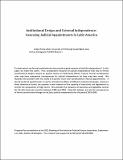| dc.contributor.author |
Aníbal Pérez-Liñan and Andrea Castagnola |
| dc.coverage.spatial |
United States |
| dc.date.accessioned |
2016-01-08T19:11:54Z |
| dc.date.available |
2016-01-08T19:11:54Z |
| dc.identifier.uri |
http://desa1.cejamericas.org:8080/handle/2015/4775 |
| dc.description.abstract |
To what extent can formal constitutional rules provide a good measure of judicial independence? In this paper we make two claims. First, comparative measures of judicial independence that rely on formal constitutional designs require an explicit theory of institutional effects. Second, formal rules may have unexpected consequences for judicial independence (or they may have none). We illustrate this problem with the study of Supreme Court and Constitutional Tribunal appointments. A formal model of appointments is used to simulate the effects of different institutional designs. Based on these theoretical results, we propose a new measure of the capacity of executives and legislatures to control the composition of high courts. We estimate the measures of executive and legislative control for 18 Latin American countries between 1900 and 2010. Using this dataset, we test the consequences of formal constitutional designs on de facto judicial independence for the period 1981-2009. |
| dc.language.iso |
English |
| dc.title |
Institutional Design and External Independence: Assessing Judicial Appointments in Latin America |
| dc.ceja.source |
Fuente: American Political Science Association |

